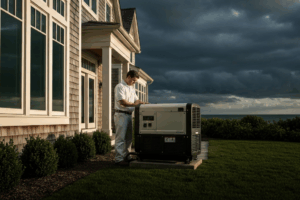What Are the Tools & Techniques for Tying Electrical Cables?
Introduction
Electrical cable management is a cornerstone of professional electrical work, ensuring safety, system longevity, and compliance with NFPA 70 (National Electrical Code, NEC). Beyond aesthetics, tying electrical cables correctly prevents hazards like overheating, physical damage, and inaccessible components. This guide provides electricians with best practices, tools, and safety protocols to create reliable, NEC-compliant installations that protect users and equipment.
The Importance of Proper Electrical Cable Management
Poor electrical cable management introduces risks:
- Heat Buildup: Tightly bundled cables trap heat, reducing ampacity and risking insulation degradation or fires (NEC 310.15(B)(3)(a)). Always consult a wire ampacity chart (NEC Table 310.16) for safe conductor sizing.
- Physical Damage: Overtightening or improper routing damages insulation, risking short circuits or ground faults (NEC 300.4).
- Reduced Accessibility: Cluttered wiring hinders maintenance, violating NEC’s accessible definition (Article 100, 314.29) for equipment like junction boxes or receptacles.
- Code Violations: Improper management risks failed inspections, fines, or liability.
Effective electrical cable management enhances reliability, simplifies troubleshooting, and ensures compliance.
Tools and Techniques for Tying Electrical Cables
Selecting appropriate tools and techniques is critical for safe, compliant installations.
- Cable Ties: Use tensioning tools to apply uniform pressure, avoiding over-tightening that damages insulation (NEC 300.4). Secure NM cables every 4.5 feet (NEC 334.30).
- Reusable Fasteners: Hook-and-loop (Velcro) straps are ideal for data cables, preventing damage and enabling modifications (NEC 800.24). Perfect for communication closets.
- Hardware: Cable clips secure individual cables to studs (NEC 300.11). Cable trays support large runs in commercial settings, ensuring airflow (NEC 392). J-hooks maintain bend radius (NEC 300.34, e.g., 5x cable diameter for NM cables).
For example, in a residential panel, neatly tied NM cables with staples ensure receptacle accessibility (NEC 314.29), preventing strain and EMI.
Implementing NEC-Compliant Electrical Cable Management
Adhering to NFPA 70 ensures safe, compliant cable management, preventing hazards and enhancing maintainability. Follow these practices for professional results.
- Spacing: Space bundles to allow heat dissipation, applying de-rating for >3 conductors (NEC 310.15(B)(3)(a)). Example: For 8 conductors, reduce 14 AWG copper ampacity from 25A to 17.5A (70%) for a 20A circuit.
- Securing: Secure cables to prevent sagging, using staples or clips every 4.5 feet for NM cables or 6 feet for MC cables (NEC 334.30, 330.30).
- Conduit Fill: Do not exceed 40% fill for >2 conductors in conduits (NEC Chapter 9, Table 1) to prevent overheating.
- Routing: Separate power and data cables to avoid EMI (NEC 800.133). Route protective surge device conductors with minimal bends (NEC 285).
- Grounding: Ensure tight ground connections for installing ground fault circuit interrupter outlets (NEC 210.8).
For a detailed guide on GFCI installation, see our article on Installing GFCI Outlets.
Ensuring Safety with NFPA 70E Protocols
- LOTO: De-energize circuits and use lock-out/tag-out (NFPA 70E 120.2, 120.5) to prevent re-energization.
- PPE: Wear insulated gloves, arc-rated clothing, and safety glasses near energized systems, especially for arc flash risks (NFPA 70E 130.7, 130.5).
- Verification: Use voltage testers to confirm circuits are de-energized (NFPA 70E 120.5). For more information on electrical safety standards, visit the official NFPA website.
Conclusion
Tying electrical cables is a hallmark of professional expertise, ensuring NFPA 70 and NFPA 70E compliance. By using proper tools, adhering to NEC requirements, and prioritizing safety, electricians create safe, reliable installations that protect users and equipment from the panel to the receptacle.
Take the next step in your professional growth! Visit Expert CE (https://expertce.com/) for all your continuing education needs.
Continuing Education by State
Select your state to view board-approved continuing education courses and requirements:
Disclaimer: The information provided in this educational content has been prepared with care to reflect current regulatory requirements for continuing education. However, licensing rules and regulations can vary by state and are subject to change. While we strive for accuracy, ExpertCE cannot guarantee that all details are complete or up to date at the time of reading. For the most current and authoritative information, always refer directly to your state’s official licensing board or regulatory agency.



